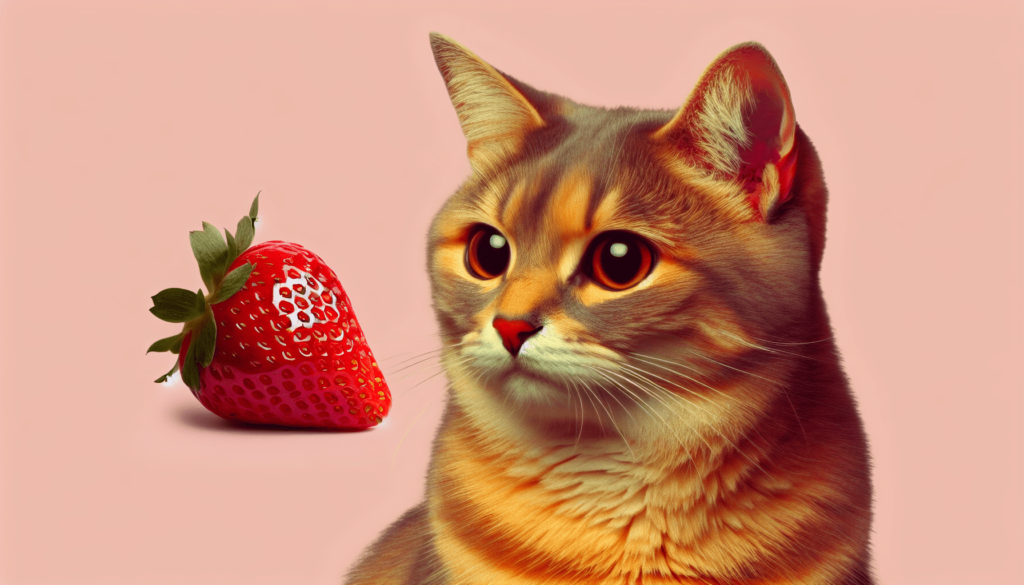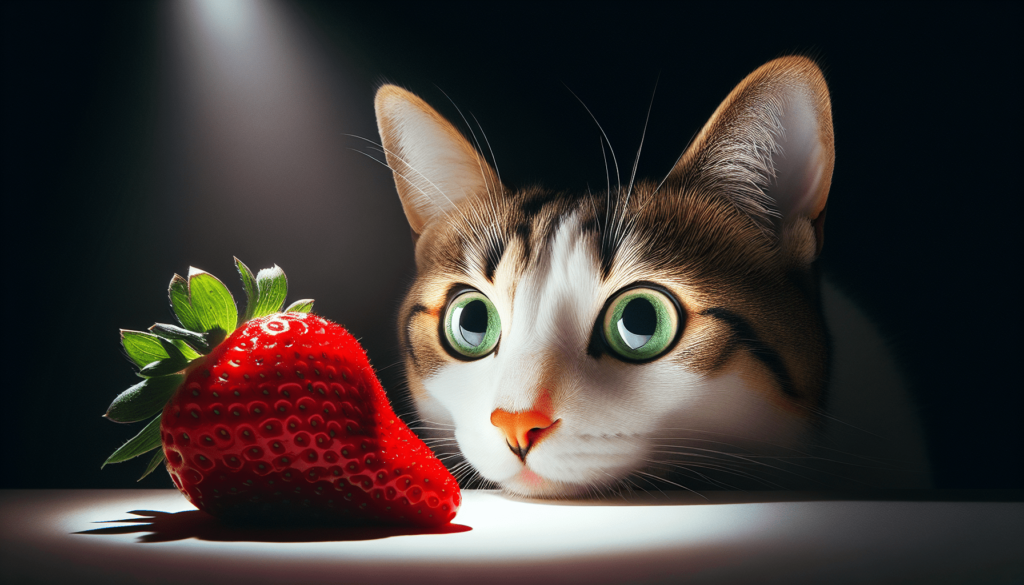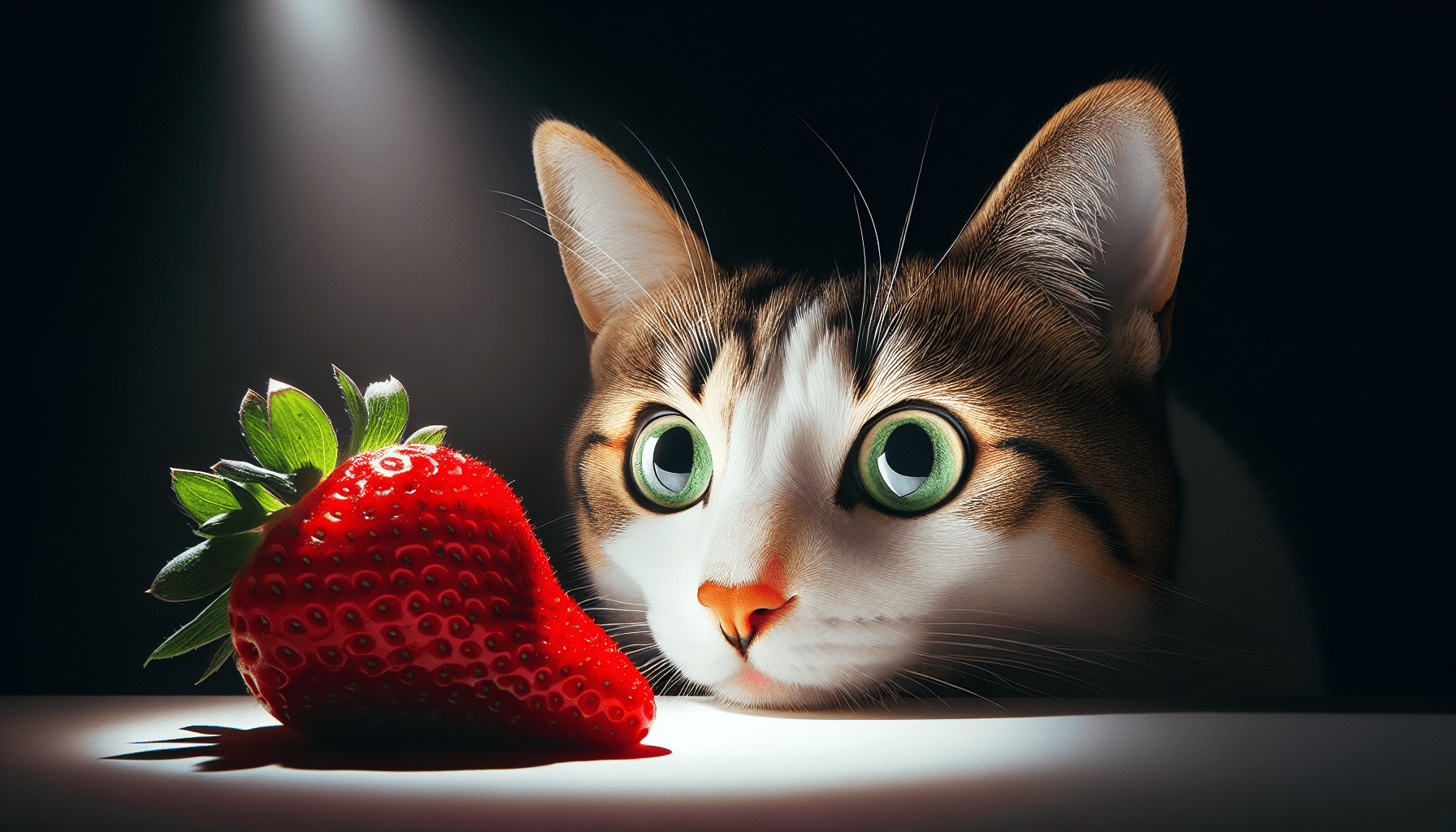Have you ever wondered if cats can enjoy the sweet taste of strawberries? Well, you’re not alone! Many cat owners have pondered this question, so let’s shed some light on the topic. While cats are primarily carnivorous animals, they can indeed eat strawberries in moderation. However, it’s important to note that strawberries should only be given as an occasional treat and never as a substitute for their regular feline diet. Let’s take a closer look at how strawberries can affect your feline friend.
Understanding A Cat’s Dietary Needs
Examining the carnivorous nature of cats
Cats are obligate carnivores, which means that their bodies are designed to thrive on a diet primarily composed of meat. Unlike humans and some other animals, cats have specific dietary needs that must be met in order for them to live healthy and happy lives. Understanding a cat’s dietary needs starts with recognizing their carnivorous nature.
Discussing the typical cat diet
The typical cat diet consists of high-quality, protein-rich animal products. This can include meat such as chicken, turkey, and fish. Cats also require certain essential nutrients, such as taurine, which is found naturally in animal tissues. Additionally, they need a balance of vitamins and minerals to support their overall health.
Examples of essential nutrients for cats
Some essential nutrients that cats require include:
-
Taurine: This amino acid is crucial for a cat’s heart health and overall wellbeing. It is found naturally in animal tissues, making a meat-based diet essential for cats.
-
Vitamin A: Cats cannot produce vitamin A from plant-based sources, which is why it’s important for them to consume it through animal products. Vitamin A is important for a cat’s vision and immune system.
-
Arachidonic Acid: Cats require arachidonic acid for healthy skin and a shiny coat. This essential fatty acid is found primarily in animal fats and is not readily available in plant-based diets.
-
Vitamin B12: Cats rely on animal-based sources for vitamin B12. This vitamin is crucial for their metabolism, nervous system, and red blood cell production.
It’s important to note that while cats require specific nutrients found in animal products, they should not be fed a diet consisting solely of strawberries or any other single food item.
Nutritional Value of Strawberries
Discussing the basic nutritional profile of strawberries
Strawberries are a delicious and nutritious fruit enjoyed by many humans. They contain several essential vitamins and minerals, including vitamin C, manganese, and folate. However, when it comes to cats, strawberries do not offer significant nutritional value due to their limited ability to digest plant-based foods.
Identifying the health benefits of strawberries
While cats may not derive significant nutritional benefits from strawberries, there are potential health benefits for humans who consume them. Strawberries are rich in antioxidants, which can help fight free radicals and reduce the risk of chronic diseases in humans. However, it’s important to remember that cats have different dietary needs and cannot derive the same benefits from strawberries.
Strawberries’ sugar content and cats
Strawberries, like many fruits, contain natural sugars. While moderate amounts of sugar can be processed by a cat’s body, excessive consumption can lead to weight gain, diabetes, and dental issues. It’s crucial to control the amount of sugar in a cat’s diet to ensure their overall health and wellbeing.

Can Cats Safely Eat Strawberries?
Analyzing the safety of strawberries for cats
Strawberries are generally considered safe for cats to consume in small amounts. However, it’s important to remember that cats are obligate carnivores and their diet should primarily consist of meat. While strawberries are not toxic to cats, they offer limited nutritional value and should not be a substantial part of their diet.
Possible allergic reactions to strawberries in cats
Just like humans, cats can be allergic to certain foods, including strawberries. Some cats may experience allergic reactions, such as itching, vomiting, or diarrhea, when they consume strawberries. It’s important to observe your cat closely after introducing strawberries to their diet and consult a veterinarian if you notice any adverse reactions.
General signs of food allergies in cats
Food allergies in cats can manifest in various ways. Some common signs of food allergies in cats include:
- Itching and scratching
- Digestive issues like vomiting or diarrhea
- Skin inflammation or rashes
- Sneezing or coughing
- Ear infections
If you suspect that your cat has a food allergy, it’s important to eliminate the potential trigger from their diet and consult with a veterinarian for further guidance and testing.
Potential Health Benefits of Strawberries for Cats
Antioxidants in strawberries and their effects on cats
While cats may not gain the same benefits from antioxidants as humans do, the presence of antioxidants in strawberries may help support a cat’s overall health. Antioxidants can help reduce inflammation and support the immune system, which can contribute to a cat’s wellbeing.
Potential dental health benefits of strawberries for cats
Strawberries have a slightly acidic nature, which can help break down plaque and tartar on a cat’s teeth. However, this benefit is not significant enough to rely solely on strawberries for a cat’s dental health. Regular dental care, including brushing and professional cleanings, should still be a priority for maintaining a cat’s oral hygiene.
Does strawberry’s high water content benefit cats?
Strawberries have a high water content, which can contribute to a cat’s overall hydration. Adequate hydration is crucial for various bodily functions and can help prevent urinary tract issues. However, cats should primarily obtain water from fresh, clean sources and a properly balanced diet, rather than relying on the high water content of strawberries alone.

Potential Risks of Feeding Strawberries to Cats
Understanding the potential choking hazard
Strawberries, like any small, solid food item, can pose a choking hazard for cats. It’s important to slice or chop strawberries into small, cat-friendly pieces to minimize this risk. Monitoring your cat while they eat strawberries can also help prevent choking incidents.
Possible negative effects of strawberries’ high sugar content on cats
Strawberries, although natural, still contain a significant amount of sugar. Excessive consumption of strawberries can lead to weight gain and potentially contribute to the development of diabetes in cats. It’s important to limit the amount of strawberries given to cats and ensure they are part of a balanced diet.
Discussing potential digestive issues from strawberries
Some cats may experience digestive issues after consuming strawberries. This can include diarrhea, vomiting, or an upset stomach. If your cat experiences these symptoms after eating strawberries, it’s best to eliminate them from their diet and consult with a veterinarian if the issues persist.
How to Serve Strawberries to Your Cat
Cleaning and preparing strawberries for your cat
Before serving strawberries to your cat, it’s crucial to thoroughly wash them to remove any pesticides or dirt. Once cleaned, you can slice or chop the strawberries into small, easily chewable pieces.
Recommended portion sizes for cats
When it comes to feeding strawberries to cats, portion control is essential. It’s recommended to give only a small amount of strawberries as an occasional treat rather than a regular part of their diet. The exact portion size can vary based on your cat’s size and overall health, so it’s important to consult with a veterinarian for specific guidance.
Blend or chop? Best ways to serve strawberries to cats
While some cats may enjoy whole strawberries, it is generally safer to chop or blend them into smaller pieces for easier consumption. This minimizes the risk of choking and helps ensure that the cat can digest the strawberries properly.
Alternatives to Strawberries for Cats
Listing cat-safe fruits
If you’re looking to offer your cat a fruit treat, there are alternative options that are safer and more nutritionally beneficial than strawberries. Some cat-safe fruits include:
- Blueberries: Rich in antioxidants and low in sugar, blueberries can be a healthy treat for cats.
- Watermelon: With its high water content, watermelon can provide hydration for cats.
- Pumpkin: A great source of fiber, pumpkin can aid in a cat’s digestion.
Remember to introduce new fruits slowly and in small quantities to ensure your cat tolerates them well.
Discussing commercial treats vs fruits for cats
Commercial cat treats are specifically formulated to meet a cat’s dietary needs and are a safer option compared to fruits. These treats are designed to provide the necessary nutrients in appropriate quantities. While fruits can be included as occasional treats, it’s important to prioritize a balanced, cat-specific diet to ensure optimal nutrition.
Understanding the benefits of a balanced, cat-specific diet
A balanced, cat-specific diet is essential for your pet’s overall health and wellbeing. Cats require certain nutrients that are best obtained through meat-based diets. While fruits like strawberries can be enjoyed in moderation, it is important to prioritize a well-rounded, nutritionally complete diet for your feline companion.
Signs Your Cat May Be Allergic to Strawberries
Identifying common allergic reactions in cats
Cats can exhibit a range of allergic reactions when exposed to allergens, including strawberries. Some common signs of food allergies in cats include itching, skin irritation, gastrointestinal issues, and respiratory problems. An allergic reaction can vary in severity, and it’s important to monitor your cat for any unusual symptoms after they consume strawberries.
What to do if you suspect your cat has a food allergy
If you suspect that your cat has a food allergy, it’s best to eliminate the suspected allergen from their diet. In the case of strawberries, this would involve discontinuing their consumption. However, it’s important to consult with a veterinarian for proper diagnosis and guidance. They may recommend an elimination diet or conduct specific tests to determine the cause of your cat’s allergic reactions.
When to seek veterinary care for your cat
If your cat exhibits severe or persistent symptoms after consuming strawberries, it’s crucial to seek veterinary care. Allergic reactions can escalate and potentially lead to more serious health issues if left untreated. A veterinarian can provide a proper diagnosis and recommend the necessary steps to manage your cat’s allergies.
How Often Can Cats Eat Strawberries?
Understanding moderation in a cat’s diet
When it comes to feeding strawberries to cats, moderation is key. While strawberries are not toxic to cats in small amounts, they should not make up a significant portion of their diet. It’s important to remember that cats require a meat-based diet to meet their nutritional needs adequately.
Discussing frequency and quantity of strawberries for cats
The frequency and quantity of strawberries for cats will vary depending on their individual needs and overall health. It’s generally recommended to offer strawberries as an occasional treat, no more than once or twice a week, and in small portions. Consulting with a veterinarian can help determine the appropriate amount of strawberries for your cat based on their specific requirements.
Impact of frequent strawberry feeding on a cat’s health
Feeding strawberries to cats too frequently can lead to various health issues. The high sugar content in strawberries can contribute to weight gain and potentially increase the risk of developing diabetes. Regularly feeding strawberries in large quantities can also upset a cat’s delicate digestive system. Therefore, it’s crucial to prioritize a balanced diet and limit strawberry consumption to occasional treats.
Conclusion
In conclusion, while cats can safely consume strawberries in small amounts, it’s essential to understand their dietary needs and the potential risks associated with feeding them this fruit. Strawberries do not provide significant nutritional value for cats, and their high sugar content can pose health risks if consumed excessively. It’s important to prioritize a balanced, meat-based diet for cats while using fruits like strawberries as occasional treats. When introducing any new food into your cat’s diet, closely observe their behavior for any adverse reactions and consult with a veterinarian for guidance. By maintaining a well-rounded, cat-specific diet, you can ensure that your feline friend stays healthy and happy.

